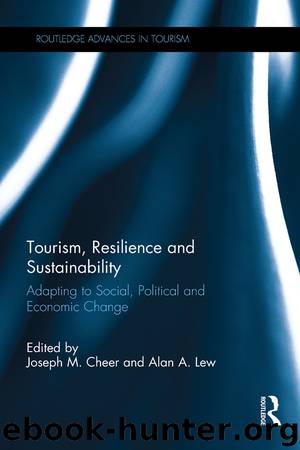Tourism, Resilience and Sustainability by Cheer Joseph M. Lew Alan A

Author:Cheer, Joseph M.,Lew, Alan A.
Language: eng
Format: epub
ISBN: 9781315464039
Publisher: Taylor & Francis (CAM)
Discussion and conclusion
Local tourism businesses in Yogyakarta showed a striking resilience to the sustained crisis in the Indonesian tourism industry. In terms of the strategies outlined earlier, the businesses showed resilience in three different ways: survival, adaptation, and modest innovation (see Table 9.2).
When crisis hit in the late 1990s, local business owners mobilized available assets, reduced operational costs, and generated additional income to keep their core business intact. During the first three years (which retrospectively can be named the first adaptive cycle marked by economic and political upheaval), business owners, confronted with declining international tourism for the first time since establishing their businesses, took measures to weather the storm while expecting tourists to return to Yogyakarta soon. As the crisis continued and accrued assets became depleted, more pro-active measures were called for. In the years of the Bali bombings (2002–2005) when the second and third adaptive cycles occurred, most businesses embraced the switch to the domestic market as the number of domestic visitors to Yogyakarta kept growing. Only a few business owners who did not respond to the challenges or focused on a return to normality went bankrupt and closed down in the process. Surprisingly, so did some businesses that opted for drastic innovation, such as the upmarket steakhouse for which the local clientele was not ready. The majority kept going by drawing on their adaptive capacities which were developed during two decades of tourism growth.
A resilient business effectively adjusts its operations, management, and marketing strategies to sustain under dramatically changing conditions (Fiksel, 2006). In particular during and immediately after the 2006 earthquake, myriad of strategies were applied across the three neighbourhoods under study. New adaptations in business operations, management, and marketing strategies, resulted in a transformation of the overall business concept (Fiksel, 2006). Such strategies included new business start-ups in sectors that catered to both (domestic) tourists and local markets, such as restaurants and food stalls, handicraft manufacturing, bike rentals, and tattoo studios. Time and again, the accommodation businesses were able to recover from the disturbances caused by yet another crisis. In particular where business could draw on redundancies (Brand & Jax, 2007; Davoudi, 2012, p. 323; Lew et al., 2016) such as sector-specific subsidiary businesses, enterprises showed the necessary elasticity to weather the storm and to generate resources to adapt to changing market conditions. In the silver industry, such redundancies were lacking because of the nature of the industry. Instead, workshop owners resumed to transforming employment relations which allowed for a reduction of production costs. However, this industry in general showed less resilience in view of the continuing crisis.
Table 9.2 Strategies of resilience
Survival Adaptation Innovation
•
Spend savings
•
Sell assets
•
Convert stocks to saleable assets
•
Downsize business
•
Close side-businesses in tourism sector
•
Reduce wages and staff
•
Change employment arrangements
•
Generate alternative non-tourism revenues
•
Switch to domestic market
•
Offer discounts
•
Adjust guesthouse to family and group accommodation
•
Diversify clientele
•
Offer new products to accommodate domestic tastes
•
New business start-ups in non-tourism sector
•
Target upmarket local clientele
•
Relocate (silver) production to low-income area
Download
This site does not store any files on its server. We only index and link to content provided by other sites. Please contact the content providers to delete copyright contents if any and email us, we'll remove relevant links or contents immediately.
International Integration of the Brazilian Economy by Elias C. Grivoyannis(86601)
The Radium Girls by Kate Moore(11873)
Turbulence by E. J. Noyes(7901)
Nudge - Improving Decisions about Health, Wealth, and Happiness by Thaler Sunstein(7469)
The Black Swan by Nassim Nicholas Taleb(6953)
Rich Dad Poor Dad by Robert T. Kiyosaki(6324)
Pioneering Portfolio Management by David F. Swensen(6175)
Man-made Catastrophes and Risk Information Concealment by Dmitry Chernov & Didier Sornette(5883)
Zero to One by Peter Thiel(5643)
Secrecy World by Jake Bernstein(4599)
Millionaire: The Philanderer, Gambler, and Duelist Who Invented Modern Finance by Janet Gleeson(4306)
Skin in the Game by Nassim Nicholas Taleb(4128)
The Age of Surveillance Capitalism by Shoshana Zuboff(4126)
The Money Culture by Michael Lewis(4033)
Bullshit Jobs by David Graeber(4001)
Skin in the Game: Hidden Asymmetries in Daily Life by Nassim Nicholas Taleb(3873)
The Dhandho Investor by Mohnish Pabrai(3642)
The Wisdom of Finance by Mihir Desai(3612)
Blockchain Basics by Daniel Drescher(3435)
